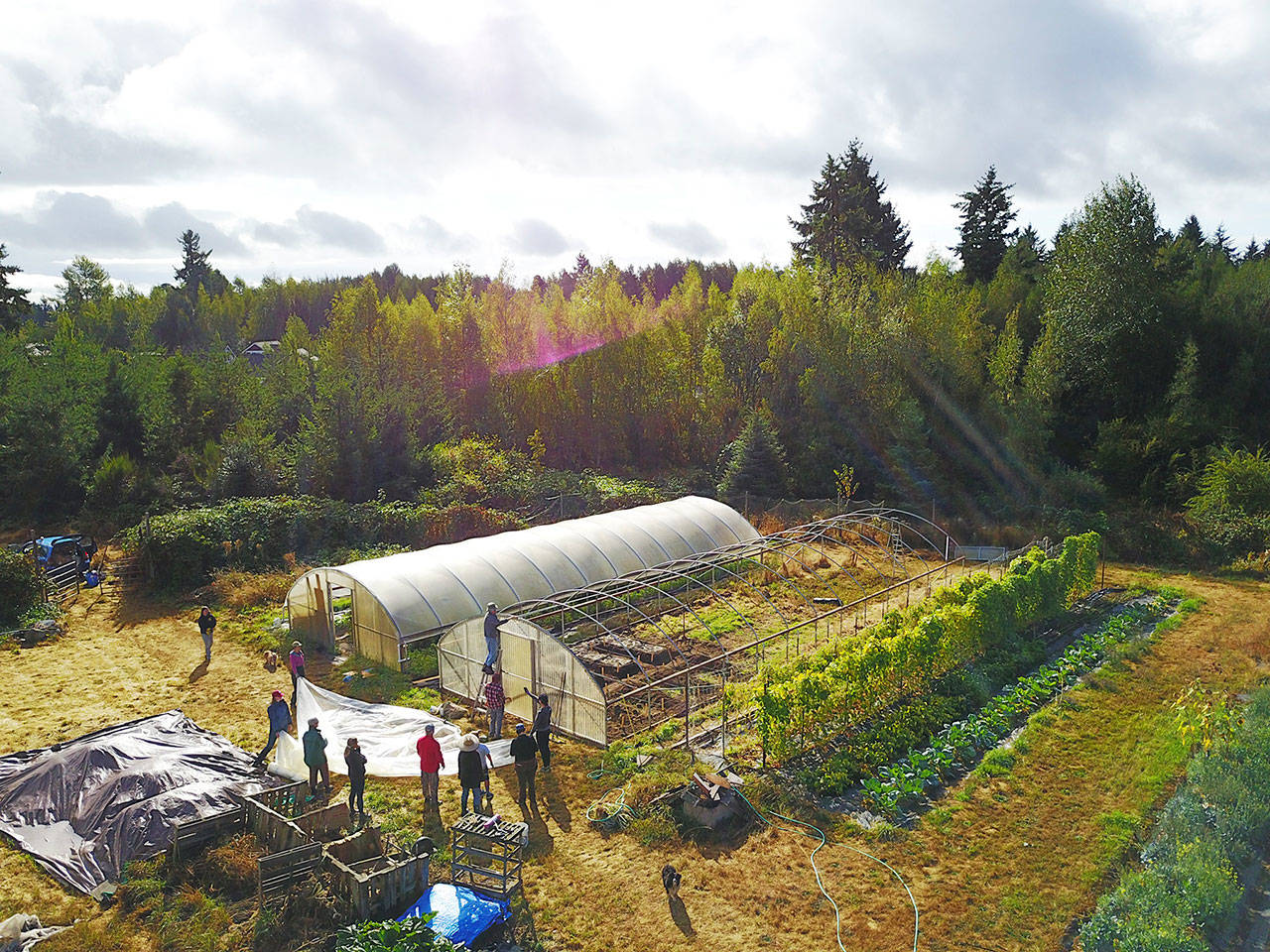Between Vashon Cohousing and the Roseballen community just to its south, a small farm run by “a motley crew of local women, men, and the odd dog or two,” as they call themselves on their Facebook page, has been quietly producing a bounty of fruits and vegetables for more than a decade.
It’s called to Shoulder to Shoulder Farm, and it is likely the island’s only farming collective. It’s a place where during this year’s farming season, which ended this month, 11 islanders banded together to accomplish a common goal: grow food for themselves and their families. They worked for four hours each week, 9 a.m. to 1 p.m. every Monday, and paid $400 each to cover seeds, water and equipment costs for the year. In exchange, they received far more than food.
“It’s such a family, just thinking of the way we’ve supported each other in the years that I’ve been there — people going through things,” Shoulder to Shoulder farmer Jessica Keenan said.
Her friend and fellow farmer Hedy Anderson agreed.
“Oh yeah, a lot of tears into that soil,” she said. “A lot of laughing too.”
In a recent interview, Anderson and Keenan talked about the end of the farming season and the insights they and their fellow farmers gained from the past nine months working the soil and harvesting together.
“There’s a range of people participating,” Anderson explained. “Some people are in it for the food, some people are more in it for the community, (for) some people it’s a way of getting out and connecting with other people.”
Keenan admitted she is “in it for the food,” but was stunned by the number of farmers who said they participated for the social and psychological benefits.
“I was amazed by how many people have the sort of mindset that growing your own food is serving your soul in some way, and not so much nourishing your body, but more your soul,” she said. “I was definitely surprised by the range of needs being met by farming together.”
But the farm has no official overarching philosophy or guiding principals encouraging farmers to pursue these deeper goals. Farmers get out of it what they need from it, according to Anderson. In fact, there is not much official about the farm and its creation at all. The 1 acre that Shoulder-to-Shoulder occupies is part of a 7-acre parcel that was purposely set aside for agriculture when Vashon HouseHold’s Roseballen was built. Many who live at Cohousing began using it for personal gardens, including islander Margaret Hoeffel who, along with the late Jean Bosch, took things a step further and started a commercial farm — Blue Moon Farm — there in 2000. The farm existed for five years before Hoeffel grew tired of the constant work and realized the farm was a lot for her and Bosch to handle.
“It was exhausting,” she said.
So she and fellow Cohousing resident Dana Schuerholz, who was using another parcel of the space for her nature school called Homestead at the time, collaborated and came up with the idea of a collective farm in 2006. At the time, its members were comprised of mostly the parents of children at Schuerholz’s school.
“She (Schuerholz) said what if interested parents at her school would work one day a week and we could have this collective of people since everything was there: greenhouses, drip irrigation system, etcetera,” Hoeffel said. “It’s just so much better to do with other people. Everybody gains knowledge and develops their specialty. The knowledge base continues to grow and you just keep doing it because it’s so much more fun.”
It was through Homestead that Anderson, who just this year finished her 10th season at Shoulder-to-Shoulder, came to become a farmer. She said her son was attending Homestead and she heard they needed another farmer.
“I worked six hours a day for six months,” Anderson said. “I had to prove myself. At the end of the year, Dana (Schuerholz) called me the Rookie of the Year and I have never received a bigger compliment.”
The time commitment has decreased since then and Anderson and the other 10 farmers spend four hours a week weeding, tilling the soil, planting and harvesting. There is a “sub list” of islanders who can step in when life gets in the way of the farming duties. In return, each farmer is entitled to a share of the bounty, everything from potatoes and tomatoes to beans, beets and carrots.
“I just think it’s a model that has worked so well for us,” Hoeffel said. “Ever since we switched to this, I think it’s a model others could use as a way to grow food and have community at the same time.”
Anderson and Keenan agree and said they feel they have a responsibility to spread the word about the collective farming model in hopes that other farmers or hobby gardeners will take advantage of its benefits.
“It’s a rare model and I cannot figure out why,” Anderson said. “It’s so few hours, it’s not a lot of money. It’s a really efficient model. No farmer (with their own farm) is going to work four hours a week and get as much food as we do.”
Anderson acknowledged that there were some long and grueling meetings in the beginning as the group solidified.
“There was a lot of negotiating … because most of us really didn’t know what it was about so we were kind of like carving our path and it was hard,” she said. “There was no system in place for dealing with interpersonal stuff and … it was a lot of work.”
But that work has paid off for Hoeffel, the 11 farmers and their families who are able to eat in-season produce and create it together.
“It’s all about appreciating the bounty,” Hoeffel said. “The bounty for the amount of work is unbelievable. We could not do this on our own.”



